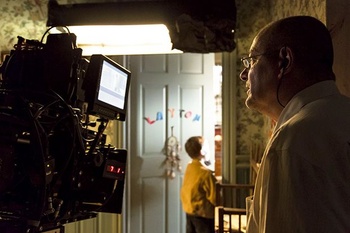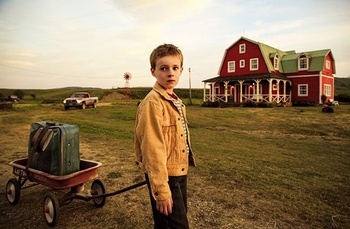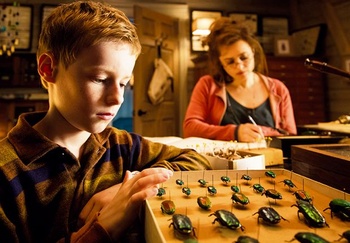Warm colours, eccentric characters, a whole world organised in the smallest, most meticulous imaginative detail, filled with multiple brilliant elements and titbits: it’s easy to spot a film by Jean-Pierre Jeunet. Even when the director of Le fabuleux destin d’Amélie Poulain swapped Paris for the wide-open plains of the America of cowboys and troubled prodigies. “All my films are derived from the same fairy-tale by Charles Perrault: Tom Thumb.”
A 12-year-old boy with an enormous passion for science and technology wins a prestigious award. T.S. Spivet decides to travel all by himself from his isolated ranch in Montana to Washington to collect the prize. The synopsis of Jean-Pierre Jeunet’s new film will not sound unfamiliar to novel lovers. The French director let his imagination run wild with the much-loved The Selected Works of T.S. Spivet by American author Reif Larsen. The book was particularly memorable for the many notes, doodles, maps, and observations the prodigy makes during his journey. “I find it very difficult to find suitable subjects,” Jeunet says. Last weekend, he was a guest of honour at the 40th Ghent Film Festival. “After I fell in love with the book, I didn’t hesitate for a second. Not only is the world of the book very similar to my own, it also seemed like the ideal opportunity to try something different: making a film in English, shooting in the great, open plains of America. Above all, I wanted to try my hand at making a film that is more poignant than my other films.”
The terrific teachings of Jean-Pierre Jeunet


This is not your first American adventure; you also made Alien: Resurrection. That was not a resounding success. Was it different this time?
Jean-Pierre Jeunet: There is no comparison. The Young and Prodigious T.S. Spivet is like Canada Dry. You think that stuff comes from Canada, but it doesn’t. You think the film is American, but actually it’s French/Canadian. I had the final cut. I could tell everybody to go hang if and when I needed to. American distributors don’t like that. Harvey Weinstein wanted to re-edit the film, but I stopped that plan dead in it’s tracks.
Nevertheless, America does play a big role in the film. After all, you are filming a ranch, a cowboy, and landscapes we know from the western genre.
Jeunet: I was ready to film an entirely different world. I can’t stand Paris anymore. I’ve scoured through that city completely, and there are no more stories for me there.
The content is based on the book, but America itself is not completely alien to me. My wife is American. I visit California often. I like the country. Though I do have my doubts about the films they make nowadays and the directors’ lack of freedom. But that’s a different issue.
Jean-Pierre Jeunet: There is no comparison. The Young and Prodigious T.S. Spivet is like Canada Dry. You think that stuff comes from Canada, but it doesn’t. You think the film is American, but actually it’s French/Canadian. I had the final cut. I could tell everybody to go hang if and when I needed to. American distributors don’t like that. Harvey Weinstein wanted to re-edit the film, but I stopped that plan dead in it’s tracks.
Nevertheless, America does play a big role in the film. After all, you are filming a ranch, a cowboy, and landscapes we know from the western genre.
Jeunet: I was ready to film an entirely different world. I can’t stand Paris anymore. I’ve scoured through that city completely, and there are no more stories for me there.
The content is based on the book, but America itself is not completely alien to me. My wife is American. I visit California often. I like the country. Though I do have my doubts about the films they make nowadays and the directors’ lack of freedom. But that’s a different issue.

All the added maps and other extras make Reif Larsen’s story really leap off the page. Was it easy to adapt that to film?
Jeunet: It seems difficult, but it is a hundred times easier to adapt an unfilmable book like that than to come up with an original screenplay. There is more to it than being confronted with a blank page. You have to scrutinise every idea for whether audiences will like it, while you already know whether people like a book, and especially whether you like it yourself. Not having to start with a blank page is very reassuring.
Reif Larsen didn’t want to collaborate on the film and that suited me fine. It is his (brain) child, but I’m its teacher. I didn’t really want him supervising me from the back of the classroom, it would have been distracting. And he understood that. We did become friends, however. I let him read the English screenplay and took his suggestions into account. He visited the set a few times and is even an extra in the scenes we shot in the Smithsonian in Washington. I had to omit a lot of the book because it is so long; the story of the grandparents for example. I had to drop the piano lessons from Amélie Poulain as well.
Are you T.S. Spivet?
Jeunet: There’s part of me in all my films. And what’s more, I’ve realised that all my films are derived from the same fairy-tale by Charles Perrault: Tom Thumb. It’s always about children who have to fight a monster and are ultimately victorious thanks to their imagination. That is the theme of all my films. I never realise that while I’m writing the script, but afterwards I can’t escape the conclusion that it’s just another re-adaptation of Tom Thumb.
Of course I can relate to that little boy who loves to make things, draw, and create. He wins a big award, which has also happened to me before. He travels to the big city by train, while I go by plane. He is confronted with manipulative media, which is not really a problem I face. Though to get media attention in France nowadays you really have to incite polemics and kick up a scandal. T.S. Spivet is uncomfortable with all that media attention and wants to go home to his ranch and drawing-board. And it’s true, I would also like to retreat to the countryside to think about my next film. But there are also differences, of course. T.S. Spivet is a little liar, which I am not.
Jeunet: It seems difficult, but it is a hundred times easier to adapt an unfilmable book like that than to come up with an original screenplay. There is more to it than being confronted with a blank page. You have to scrutinise every idea for whether audiences will like it, while you already know whether people like a book, and especially whether you like it yourself. Not having to start with a blank page is very reassuring.
Reif Larsen didn’t want to collaborate on the film and that suited me fine. It is his (brain) child, but I’m its teacher. I didn’t really want him supervising me from the back of the classroom, it would have been distracting. And he understood that. We did become friends, however. I let him read the English screenplay and took his suggestions into account. He visited the set a few times and is even an extra in the scenes we shot in the Smithsonian in Washington. I had to omit a lot of the book because it is so long; the story of the grandparents for example. I had to drop the piano lessons from Amélie Poulain as well.
Are you T.S. Spivet?
Jeunet: There’s part of me in all my films. And what’s more, I’ve realised that all my films are derived from the same fairy-tale by Charles Perrault: Tom Thumb. It’s always about children who have to fight a monster and are ultimately victorious thanks to their imagination. That is the theme of all my films. I never realise that while I’m writing the script, but afterwards I can’t escape the conclusion that it’s just another re-adaptation of Tom Thumb.
Of course I can relate to that little boy who loves to make things, draw, and create. He wins a big award, which has also happened to me before. He travels to the big city by train, while I go by plane. He is confronted with manipulative media, which is not really a problem I face. Though to get media attention in France nowadays you really have to incite polemics and kick up a scandal. T.S. Spivet is uncomfortable with all that media attention and wants to go home to his ranch and drawing-board. And it’s true, I would also like to retreat to the countryside to think about my next film. But there are also differences, of course. T.S. Spivet is a little liar, which I am not.

You have a very fertile imagination.
Jeunet: You can’t make it without imagination. Spivet’s life is characterised by a duality between poetry and science. He describes the sun twice on the train: once scientifically, and then again via a poem by Baudelaire. That is the definition of cinema: technology and creation. The art is in combining those opposites. As an adolescent, I hesitated about choosing a technical programme – I liked making amplifiers and tinkering with electronics – or making films. I thought I had to choose. Later on, I discovered that those two things come together in making films. Especially if you start in animation like I did. Then you have to make something before you film it.
What did you think of Ang Lee’s Life of Pi? On your website you describe how much time and energy you spent trying to make a film of Yann Martel’s book, but all in vain.
Jeunet: When I was trying to get that film off the ground, 3D had not become fashionable yet and it was too early for a CGI tiger like the one in Ang Lee’s film. And putting a young boy in a boat with a real tiger is not recommended. Technically, the project was an extremely complicated challenge. We thought about using a real tiger surrounded by nine cameras. But I couldn’t make the film because it turned out to be too expensive. My budget was capped at 60 million dollars. I had budgeted for 59 million, but at the time the dollar was too weak against the euro.
Thanks to his friendship with the president of the Republic of Taiwan, Ang Lee had a budget of 150 million. Taiwan paid for Life of Pi. Technically, his film is formidable. Three years after my project, a CGI tiger had become possible. My only criticism is that the film is too much of a copy/paste from the book. I had planned to make more of an adaptation. But things didn’t go my way. It happens. And if I had made Life of Pi, there would have been no Micmacs à tire-larigot or The Young and Prodigious T.S. Spivet.
> REVIEW + TRAILER
Jeunet: You can’t make it without imagination. Spivet’s life is characterised by a duality between poetry and science. He describes the sun twice on the train: once scientifically, and then again via a poem by Baudelaire. That is the definition of cinema: technology and creation. The art is in combining those opposites. As an adolescent, I hesitated about choosing a technical programme – I liked making amplifiers and tinkering with electronics – or making films. I thought I had to choose. Later on, I discovered that those two things come together in making films. Especially if you start in animation like I did. Then you have to make something before you film it.
What did you think of Ang Lee’s Life of Pi? On your website you describe how much time and energy you spent trying to make a film of Yann Martel’s book, but all in vain.
Jeunet: When I was trying to get that film off the ground, 3D had not become fashionable yet and it was too early for a CGI tiger like the one in Ang Lee’s film. And putting a young boy in a boat with a real tiger is not recommended. Technically, the project was an extremely complicated challenge. We thought about using a real tiger surrounded by nine cameras. But I couldn’t make the film because it turned out to be too expensive. My budget was capped at 60 million dollars. I had budgeted for 59 million, but at the time the dollar was too weak against the euro.
Thanks to his friendship with the president of the Republic of Taiwan, Ang Lee had a budget of 150 million. Taiwan paid for Life of Pi. Technically, his film is formidable. Three years after my project, a CGI tiger had become possible. My only criticism is that the film is too much of a copy/paste from the book. I had planned to make more of an adaptation. But things didn’t go my way. It happens. And if I had made Life of Pi, there would have been no Micmacs à tire-larigot or The Young and Prodigious T.S. Spivet.
> REVIEW + TRAILER
Read more about: Film
Fijn dat je wil reageren. Wie reageert, gaat akkoord met onze huisregels. Hoe reageren via Disqus? Een woordje uitleg.